
PSYC 377
Physiological Psychology Exam 3 Study Guide
Basic Pharmacology
an exogenous
chemical not necessary for normal cellular function that
significantly alters the function of certain cells when taken in
fairly low doses.
drugs that
alter mood, thought, or behavior --must be able to cross the
Blood-Brain Barrier ;most used to manage/treat psychopathology;
some used recreationally.
Drug Naming Conventions
Example:
7-cloro-1,3-dihydro-1-methyl-5-phenyl-2H-benzodiazepin-2-one
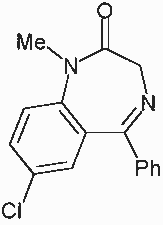
-
Generic Name (nonproprietary Name):
Example:
diazepam
-
Trade name (proprietary name):
Example:
Valium
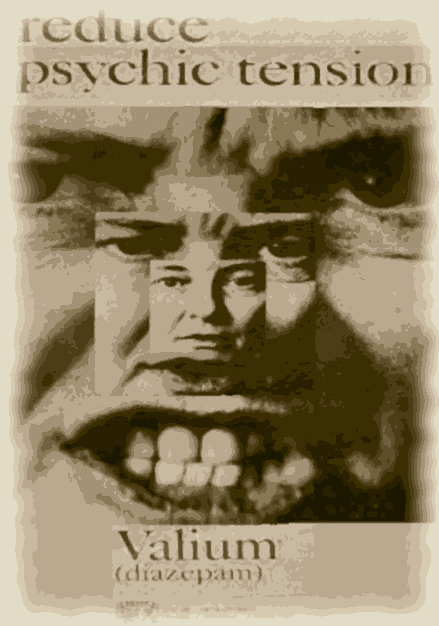
Drug
Doses: mg/kg (body weight)
Needed to
standardize concentration of drug across subjects when
measuring:
-
Drug Distribution parameters (Pharmacokinetics)
-
Drug Actions at target receptor proteins
(Pharmacodynamics)
-
Behavioral changes induced by 1 and 2 above
(Psychophysics)
Dose
Response Curves (DRC)
A Cartesian
Plot in which the X-axis plots concentration of a drug or
hormone. The Y-axis plots response, which could be almost
anything. For example, the response might be enzyme activity,
accumulation of an intracellular second messenger, membrane
potential, secretion of a hormone, heart rate or contraction of a
muscle. Remember that the term "dose" strictly only applies to
experiments performed with animals or people, where you
administer various doses of drug. However, the term
"dose-response curve" is also used more loosely to describe in
vitro experiments where you apply known concentrations of drugs.
Dose-response experiments typically use 10-20 doses of drug,
approximately equally spaced on a logarithmic scale. For example
doses might be 1, 3, 10, 30, 100, 300, 1000, 3000, and 10000 nM.
When converted to logarithms, these values are equally spaced:
0.0, 0.5, 1.0, 1.5, 2.0, 2.5, 3.0, 3.5, and 4.0. Note: The
logarithm of 3 is actually 0.4771, not 0.50. The antilog of 0.5
is 3.1623. So to make the doses truly equally spaced on a log
scale, the concentrations ought to be 1.0, 3.1623, 10.0, 31.623
etc.
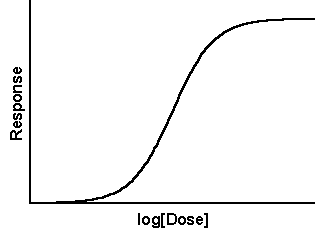
-
ED50 - median effective dose
-
LD50 - median lethal dose
-
TD50 - median toxic dose (clinical trials/human
subjects)
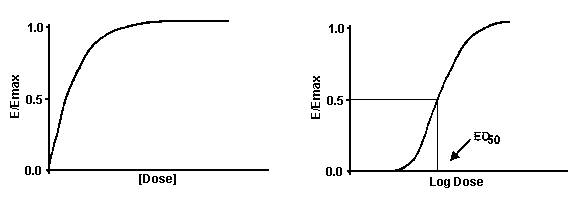
DRCs and Drug Safety:
-
Therapeutic index (TI)= LD50 or TD50/ED50
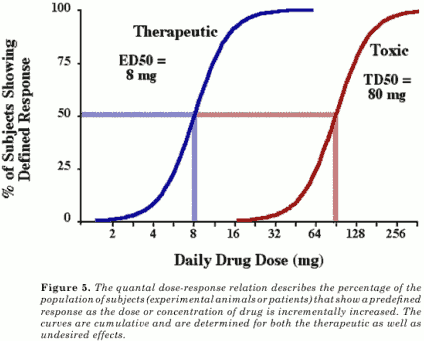
-
Potency: differences on the ED50 of drugs that have the same
effect
-
Effectiveness (efficacy): differences in the maximum effect of
two drugs
-
Primary effects: The specific effect being measured at a
specific point in time
-
Side effects: Other effects occuring concommitantly with a
primary effect measurement
Drug
Interactions
-
Antagonism: shifts the ED50 to the right
-
Additive effect: shifts ED50 to the left
-
Super additive effect (potentiation): Example would be Drug A
having a completely flat DRC by itself-- but evidencing a
dynamic dose response function in the presence of Drug
B.
Pharmacokinetics
How drugs
get into, around and out of the body.
-
Site of action: The point where you begin studying
pharmacodynamics.
-
Routes of Administration: The first phase (step) in the study
of pharmacokinetics
Parenteral (injection) Administration Routes
-
vehicle: Must be inert and compatable with the tissues being
"invaded" by the needle.
-
s.c.: subcutaneous or "sub-q"-- the needle (and drug/vehicle
bolus) is placed under the most superficial layers of skin but
above the underlying muscle tissues-- results in slow,
sustained pharmacokinetic absorbtion profiles.
-
i.m.: intramuscular -- the needle (and drug/vehicle bolus) is
placed into the belly of large striated muscle tissues--
results in more rapid pharmacokinetic absorbtion profiles than
sub-q.
-
i.p.: intraperitoneal -- the needle (and drug/vehicle bolus) is
placed into peritoneal cavity containing all of the abdominal
organs-- results in more rapid pharmacokinetic absorbtion
profiles than sub-q or i.m.-- very rarely used in humans
because of our unique abdominal musculature.
-
i.v.: intravenous --the needle (and drug/vehicle bolus) is
placed directly into a vessel of the venous circulatory
system-- results in extremely rapid pharmacokinetic profiles
--in a sense absorbtion is "bypassed". In animal research a
permantly inplanted i.v. catheter may be employed to examine
behavioral phenomena such as drug self- administration (yes
animals will use drugs recreationally and will even "pay" more
for drugs they really "like").
Diffusion:
substances
tend to move from areas of high concentration to areas of low
concentration until concentration is equal in both
areas.
Diffusion
works between liquids and gasses --lungs are an efficient gas
exchange system: oxygen in-CO2 out --Smoke and solids --snuff -
tobacco, cocaine, heroin, etc.
Oral administration: (p.o.):
Digestive
system --lipid barrier between food and blood; lipid solubility
determines absorption
partition coefficient
Factors that
determine lipid solubility
Determinants
of ionization:
1. pH of solvent
2. acidity/alkalinity of drug
3. pKa of drug
The tendency
for acid drugs to get trapped on the basic side of a membrane and
basic drugs to get trapped on the acid side of a membrane. Only
nonionized molecules can diffuse through membrane. They reach
equal concentration on both sides. The law of diffusion only
applies to the nonionized molecules.Thus, only the concentration
of nonionized molecules will be equal on both sides of a
membrane.
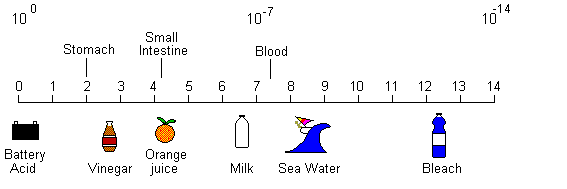
This section
is for those in class (and you know who you are) who needed to
know "the mystical numbers" and how one obtains them -- you must
not use this knowledge to harm your fellow earthlings or there
will be retribution (I'll make you do the calculations on the
exam without giving you the formulae --insert evil laughter
here).
-
Acid Base Calculations and Solubility/Permeability of potential
pharmaceutical compounds.
-
Acid/base chemistry is a very simple proton transfer
equilibrium. A generic example where AH is any acid and
A- is the conjugate base is given below.

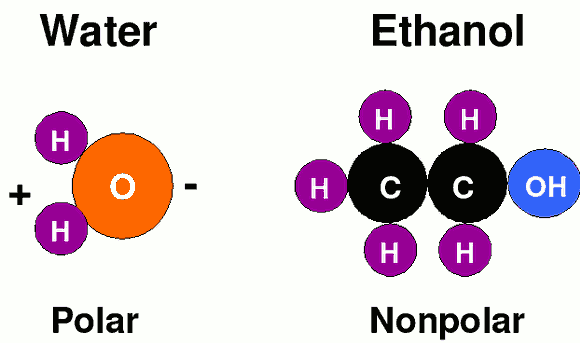
When we
measure the pH of a solution, we are measuring the concentration
of hydrogen atoms (actually H3O+) in solution. Strong acids
will increase the number of hydrogen atoms and strong bases will
decrease the number of hydrogen atoms. By definition a
strong base is a weak acid (just look at the equilibrium
above).
The
equilibrium constant K is defined as the fraction of H+ and
A- to the HA.
K = ([H+]
[A-] ) / [HA] , for this equilibrium K is called Ka
for acid dissociation constant.
Since we are
interested in the amount of H+ we need to arrange the equation to
just have [H+] in one side.
[H+] = Ka
([HA]/[A-] )
Taking the
logarithm of each side gives:
log
[H+] = log Ka + log ([HA]/[A-] )
Now we can
multiple by -1.
-log
[H+] = -log Ka - log ([HA]/[A-] )
Which is the
same as:
-log
[H+] = -log Ka + log ([A-] /[HA])
Traditionally,
-log is substituted with a lower case p, so the equation becomes
(known as the Henderson-Hasselback equation:
pH = pKa +
log ([A-] /[HA])
So if we
know the pH of a solution and the pKa the acid we can determine
how much [A-] and [HA] we have in solution, using the rearranged
equation below.
[A-] /[HA] =
exp (pH - pKa)
This means
that when pH is equal to pKa , [A-] = [HA], or that the
acid is 50% ionized.
Drug, acid,
pKa=3.5
Side A,
pH=3.5,
ionization=50%,
i.e, 1/2
Side B, pH=
7.5
ionization=
.00001 i.e, 1/10,000
Now, only
the nonionized molecules will be in equilibrium. This means that
for each nonionized molecule on side A there will be only one
ionized
molecule,
but for each nonionized molecule on side B there will be 10,000
ionized molecules. Thus, there will be 10,000 more molecules on
side B than side A.
-
Transdermal administration
epidermis
packed with keratin EG: nicotine
patch
Distribution - where drugs go in the body.
Lipid
solubility - highly lipid soluble drugs tend to concentrate in
the lipids and water soluble drugs concentrate in body
water.
Barriers:

Transport
mechanisms:
Excretion
and metabolism:
-
Kidneys: filter everything out and reabsorb what is needed and
what is lipid soluble. Reabsorption is altered by
pH.
-
Liver: Chemical factory controlled by enzymes
enzymes:
Factors
altering rate of metabolism:
1. Induction and blocking of enzymes
(antabuse
blocks acetaldehyde dehydrogenase)
2. age
3. species
-
First pass metabolism: metabolism before drug is fully
absorbed.
-
Combining absorption and excretion functions
-
Time course for drug concentration determined by rate of
absorption and rate of excretion.
-
Different for different routes of administration. Half-life:
time taken to reduce drug concentration by ½
-
Therapeutic window: Drug concentration above the therapeutic
level and below the toxic level.
Pharmacodynamics
- Drug Effects and Sites of Action

The Dopamine Reinforcement Pathway
The Four
Figures Below depict the site of action of drugs of abuse from
different perspectives. The first
figure shows the anatomy of the "reinforcement pathway" in a rat
brain. The second
and third figures show an exaggerated "close-up" view of a
hypothetical synapse between the VTA and the Nucleus Accumbens
(The Nucleus Accumbens has different abbreviations in the
different figures--so be careful when you are studying--it can
have either of the following abbreviations: Acc,
NAcc).The fourth
figure depicts the "reinforcement circuit" in a human
brain.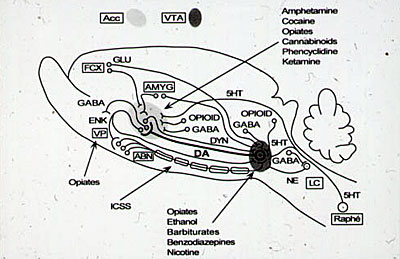
Schematic
diagram of the brain-reward circuitry of the mammalian
(laboratory rat) brain, with sites at which various abusable
substances appear to act to enhance brain-reward and thus to
induce drug-taking behavior and possibly drug-craving.
ICSS, descending,
myelinated, moderately-fast-conducting component of the
brain-reward circuitry that is preferentially activated by
electrical intracranial self-stimulation., DA subcomponent of the ascending
mesolimbic dopaminergic system that appears preferentially
activated by abusable substances: Raphé brain stem serotonergic raphé
nuclei LC, locus
coeruleus; VTA ventral
tegmental area; Acc,
nucleus accumbens; VP,
ventral pallidum; ABN,
anterior bed nuclei of the medial forebrain bundle; AMYG, amydala; FCX frontal cortex: 5HT, serotonergic
(5-Hydroxytryptamine) fibers, which originate in the anterior
raphé nuclei and project to both the cell body region (ventral
tegmental area) and terminal projection field (nucleus accumbens)
of the DA reward neurons; NE, noradrenergic fibers, which
originate in the locus coeruleus and synapse into the general
vicinity of the ventral mesencephalic DA cell fields of the
ventral tegmental area; GABA, GABAerqic inhibitory fiber
systems synapsing upon the locus coeruleus noradrenergic fibers,
the ventral tegmental area, and the nucleus accumbens, as well as
the GABAergic outflow from the nucleus accumbens; Opioid, endogenous opioid peptide
neural systems synapsing into both the ventral tegmental DA cell
fields and the nucleus accumbens DA terminal projection loci;
ENK, enkephalinergic
outflow from the nucleus accumbens; DYN, dynorphinergic outflow from the
nucleus accumbens; GLU,
glutamatergic neural systems originating in frontal cortex and
synapsing in both the ventral tegmental area and the nucleus
accumbens.
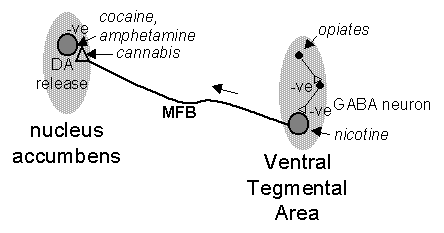
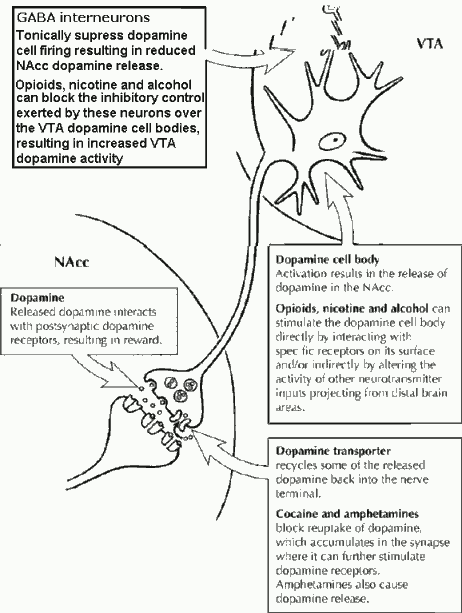
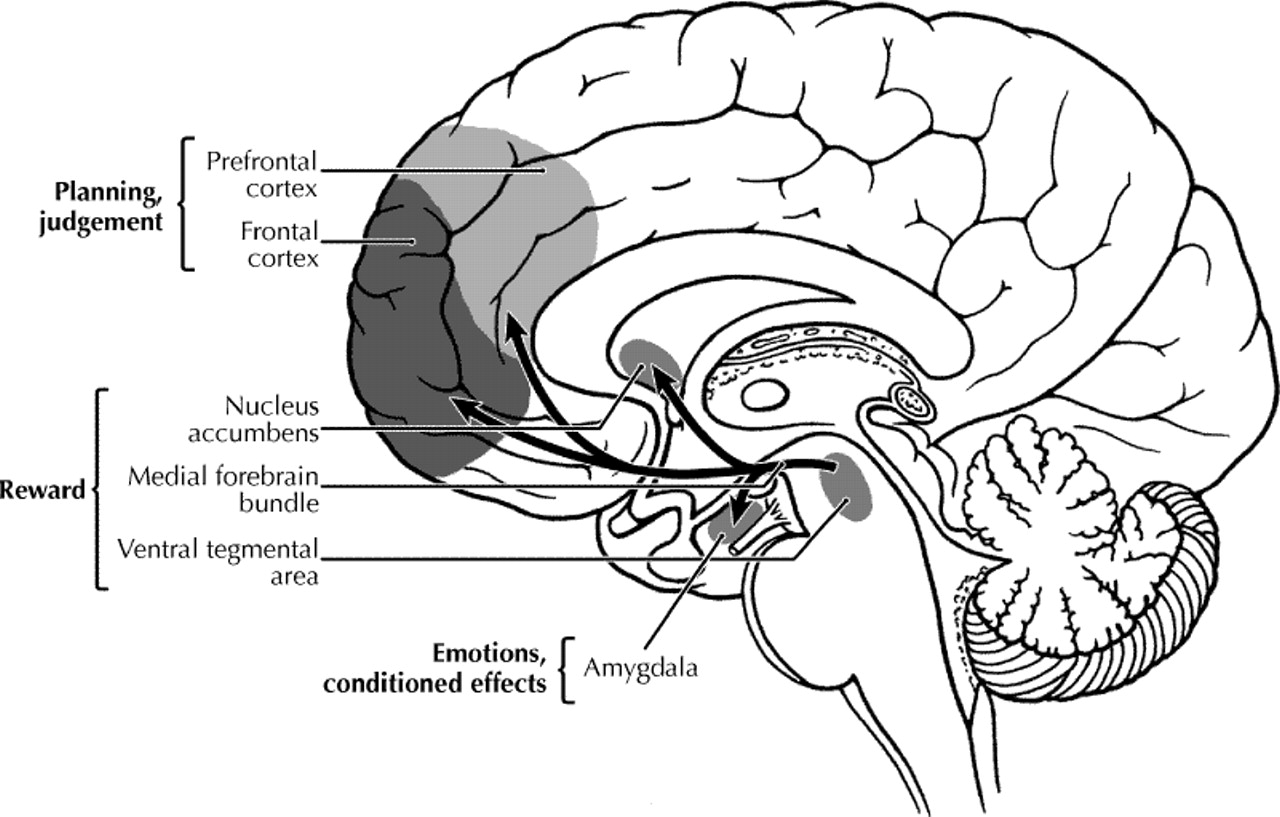
-
It is now known that the reinforcement or reward system of the
brain is mediated by one of the major dopaminergic pathways
followed by the Medial Forebrain Bundle (MFB). The MFB sends
fibres from neurons of the Ventral Tegmental Area (VTA) to the
other forebrain nuclei including the septum and the prefrontal
cortex and (importantly) to the Nucleus Accumbens. Animals
(including humans) will do a lot of work to receive stimulation
to the MFB.
-
A laboratory preparation can be constructed in which an
electrode delivers microlitres of a drug to specific brain
regions when an animal presses a lever. Animals will press the
lever at extremely high rates for delivery of drugs directly
into different parts of the reinforcement pathway (usually VTA
or nucleus accumbens) - this is usually accompanied by an
increase in DA release at the nucleus accumbens.
-
All drugs with a potential for abuse appear to (directly or
indirectly) increase DA activity in this pathway. Such drugs
include: alcohol, cocaine, amphetamine, nicotine, morphine,
methadone, methylenedioxyamphetamine (MDA),
methylenedioxymethamphetamine (MDMA or ecstasy), phencyclidine
(PCP or angel dust) and cathinone. The specific role of DA in
this pathway appears to be to decrease activity in the Nucleus
Accumbens.
The
following list is an summary of the known effects of selected
drugs.
-
Opiates (heroin, morphine, opium)
Act on the
MFB via opiate receptors on cells of the Ventral Tegmental Area.
These opiate receptor containing cells themselves inhibit
GABA-ergic neurons which synapse onto the DA pathway. The removal
of GABA-ergic inhibition allows the DA cells to fire at a higher
frequency thus inhibiting the NA. When the activity of a brain
under the influence of morphine is viewed by positron emission
tomography (PET), the cerebral cortex shuts down but underlying
centres associated with emotion remain active.
-
Cocaine, amphetamine, cathinone
These
substances both act on dopaminergic nerve terminals which synapse
onto cells in the nucleus accumbens and septum. They increase
release from the synapse by inhibiting re-uptake of dopamine -
indeed amphetamine appears to actually reverse the re-uptake
mechanism causing more DA to be released. Cocaine boosts the
activity of the whole brain especially the primitive emotional
structures. Long-term abusers of amphetamine and cocaine develop
psychosis-like symptoms - hallucinations, paranoia, mood
disturbances and repetitive behaviours which led to the proposal
of the dopamine theory of schizophrenia.
Stimulates
nicotinic receptors (a subclass of acetylcholine receptors)
including the VTA dopaminergic cells which carry such receptors..
The reinforcing effect of nicotine is therefore believed to be
due to its effect on the release of DA in the nucleus accumbens.
Although nucleus accumbens neurons carry receptors for nicotine
this region does not appear to be directly involved in nicotine's
reinforcing effects. Interesting most other drugs of abuse
actually decrease ACh activity.
-
Alcohol, benzodiazepines, barbiturates, inhaled
solvents
In low
doses, alcohol appears to act on the brain by stimulating the
GABA-benzodiazepine receptor complex (inhibitory), and by
becoming incorporated into all neuronal membranes and making them
less excitable. In the DA reward pathway alcohol causes an
increase in the firing rate of cells in the ventral tegmental
area and a consequent increase in the release of DA at the
nucleus accumbens. The precise mechanism involved in these
effects is not clear at present.
D
9-tetrahydrocannabinol (THC), the active ingredient of marijuana,
acts on cannabinoid receptors - the endogenous neurotransmitter
which they bind is called anandamide (from the Sanskrit word
"Ananda" meaning bliss), its role is not presently known. These
are widespread through the brain with few receptors in the brain
stem or and spinal cord (Herkenham et al., 1991). The receptors
are particularly dense in the hippocampus (responsible for memory
processing), the cortex (cognitive function) and the basal
ganglia and cerebellum (structures involved in movement control).
THC injection into the nucleus accumbens increases DA levels
while injection into the VTA does not - this suggests that the
reinforcing effects of cannabis are due to its effect on DA
synapses - probably by binding to presynaptic
heteroreceptors.
The following substances are not "addictive" in the typical
sense--it has been hypothesized that their serotonergic (5-HT)
effects may modulate the changes in the VTA-NAcc dopamine
system.
-
Lysergic acid diethylamide (LSD)
LSD acts on
neurons which use the neurotransmitter serotonin (5-HT) largely
because of its structural similarity to the neurotransmitter. It
has a great affinity for the 5-HT2 receptor. Pathways which
contain serotonergic neurons are involved in many aspects of
behaviour including the control of eating, mood, sleep, arousal,
the regulation of pain and in the control of dreaming. The
relation to the DA reward system is unknown.
-
3,4-Methylenedioxymethamphetamine (MDMA or ecstasy)
MDMA has
both amphetamine-like (at lower doses) and hallucinogenic (at
higher doses) properties. Its neurochemistry reflects this -
lower doses stimulate the release of DA (including in the nucleus
accumbens) and as the dose increases this is accompanied by
serotonergic effects - in fact it inhibits the re-uptake of
serotonin.
OPERANT
LEARNING
-
DEFINITION: OPERANT LEARNING– Behavior is a
function of its consequences
A. Positive Reinforcement:
strengthens learning by giving the subject something that
increases its behavior (usually something desirable)
B. Negative
Reinforcement:strengthens learning by removing something
painful or aversive (note: also increases behavior)
C. Positive Punishment: weakens
learning by giving the subject something that decreases its
behavior (usually something painful)
D. Negative Punishment:weakens
learning by taking away something that the subject finds
reinforcing… (note: also decreases behavior).
E. BE PREPARED TO ANSWER
QUESTIONS ABOUT THORNDIKE’S DISCRETE TRIALS OPERANT STUDIES AND
SKINNER’S FREE RUNNING OPERANT STUDIES (SCHEDULES OF
REINFORCEMENT, ETC)
F. KNOW THE PATTERNS OF
RESPONDING THAT ARE TYPICAL OF FIXED RATIO (FR) AND FIXED
INTERVAL (FI) SCHEDULES OF REINFORCEMENT
G. REINFORCEMENT "WORKS" BY INCREASING ACTIVITY IN
THE VTA-NA CIRCUIT! THUS RECREATIONAL DRUG USE IS A TYPE OF
LEARNING--THE BEHAVIOR THAT IS REINFORCED BY THE DRUG IS THAT
OF OBTAINING AND ADMINISTERING THE DRUG!















